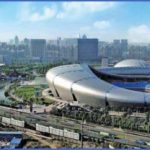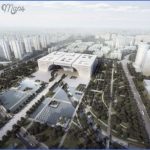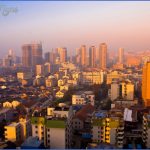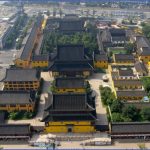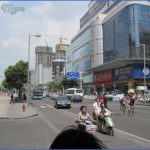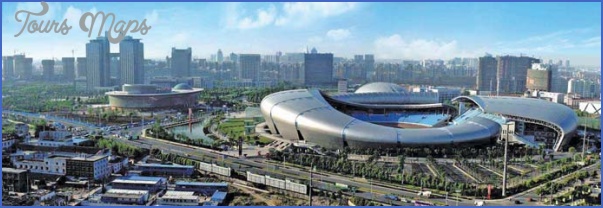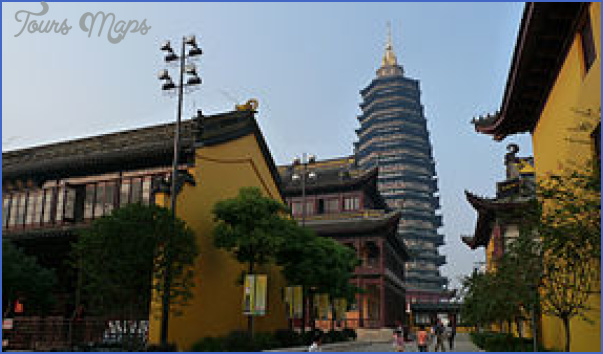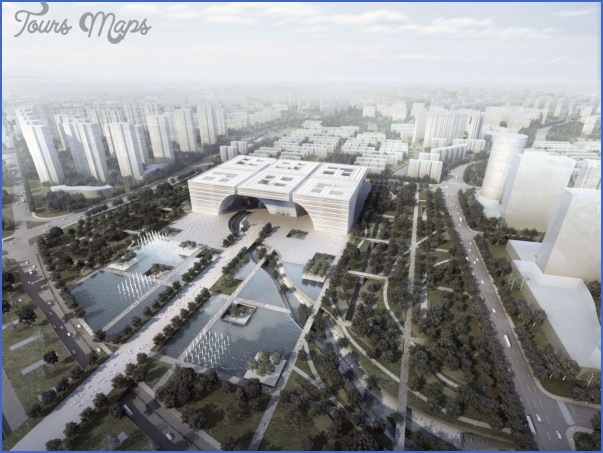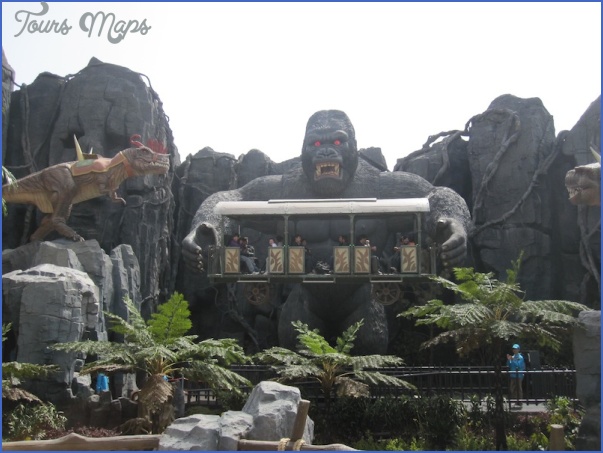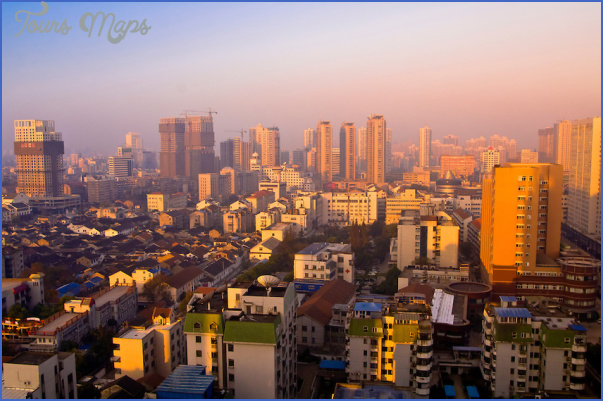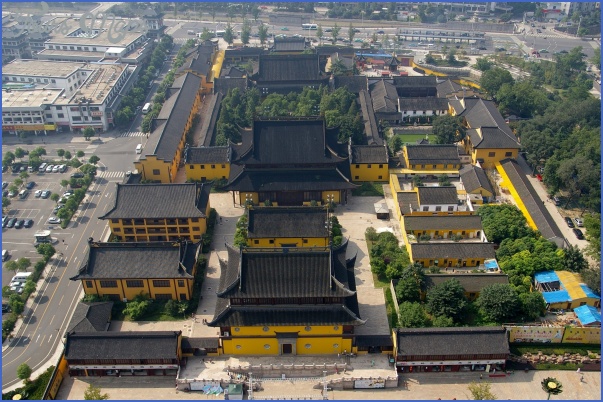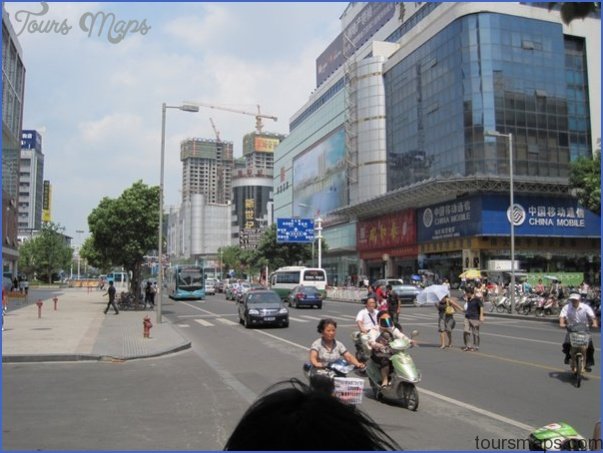Temple ofthe Beginning of Blissful Happiness (Kaifu Si)
This temple in Kaifu Si Street was erected in 907. After repeated acts of destruction overthe centuries the major buildings have now been restored. The complex includes the Halls of Sansheng Dian and Pilu Dian, as well as the Hall of the Great Buddha (Daxiong Badian) which was rebuilt in 1923. The temple houses two inscribed stone tablets dating from the 17th and 19th c.
Han Graves in Mawangdui (Mawangdui Hanmu)
The three Han Graves, 4km/2% miles north-east of the town, came to light during excavations carried out between 1972 and 1974. They belonged to a noble family who lived at the beginning of the Western Han dynasty (206-24 B.C.).
The first tomb, that of the wife of Prince Li Cang, held a completely preserved mummy together with rich grave-goods which are now housed in the provincial museum in Changsha; these included inscriptions and paintings on silk, books written on bamboo leaves, lacquered objects and silken textiles. The other two graves were for the Prince and his son.
The house where Mao Zedong (Tse-tung) was born in 1893, the son of a well-to-do farmer, and where he lived until 1910, stands in the village of Shaoshan, 100km/60 miles from Changsha. In 1912 Mao moved to Changsha in order to attend the college there.
Built in typical Hunan style, the house was made into a museum in 1964. On display are personal items owned by the young Mao together with photos from his revolutionary period.
The town has been in existence for more than 2500 years. Thanks to its situation on the Grand Canal -the extremely important transportation and trade route which was first constructed in the 5th c. b.c. and has been extended several times since – Changzhou has enjoyed periods of rapid and thriving expansion.
Today it is one of the major industrial towns in Jiangsu province, especially in the spheres of food production, textiles and machinery.
The Temple of Heavenly Peace situated in the Old Town and known as the Monastery of Great Rapture (Guangfu Si) until the year 1111, was built in 901-04. This colossal building complex, which consists of eight temples, 25 palaces and some 500 houses, was once the most important Buddhist monastery in the whole of south-east China. Unfortunately only 500 bas-reliefs and an equal number of arhats have been preserved. The present buildings were rebuilt during the Qing dynasty (1644-1911).
Every sixty years the “Great Buddhist Tonsure” (Chuanjie Dafahui) is celebrated. The last celebrations were held in 1990.
In the centre, in Plum Tree Park, stands the Hongmei Ge Pavilion, built in 1008-16. This two-storey building, 17m/56ft tall, was rebuilt in 1295 after the original had been destroyed by arsonists.
The park is known in particular for the red blossom on the plum trees in March and April.
This garden, landscaped in the Ming style and the only one of its kind in the whole of southern China, was laid outintheQing period, between 1688and 1672.
This mountain palace, used by the imperial court as a summer retreat, lies in a valley surrounded by high mountains to the north of the town. Its construction commenced in 1703 under the Jiangxi Emperor Xuangye, but it was not completed until 1790. The Qianlong Emperor Hongli extended it with buildings in various national styles. When the Jiaqing Emperor was struck down by lightning nearthe palace in 1820 the court regarded this as a bad omen and left the palace never to return. The residence comprises over 110 buildings, covers an area of 560ha/1400 acres and is surrounded by a wall 10km/6’/« miles long. The complex reveals both north and south Chinese building styles and is divided into two sections-the palace area and the landscaped gardens.
Visitors enter the relatively small palace area through the Gateway of Beauty (Lizheng Men), which has three entrance passages, a large central one which was reserved for the Emperor and two smaller ones at the side. The following buildings make up the whole complex: the Main Hall (Zheng Gong), decorated with rich carvings in the finest nanmu wood, where the Emperor received his ministers, generals, representatives of national minorities and diplomatic envoys; the Palace of Foaming Waves (Qing Gong) which contained the Emperor’s bed-chamber: The Hall of Pine and Cranes (Songhe Zhai), where the mothers and some of the Emperor’s concubines lived; the Hall of The Sighing Pines and Ten Thousand Valleys, which the Emperor used for study and rest.
The parkland behind the palace covers a large part of the whole complex and is itself divided into three parts – the lake area, which boasts various kinds of summer-houses, pavilions and stone bridges, the hilly part and the flat gardens.
Its most picturesque and attractive features are the artificially laid-out south Chinese private gardens, in imitation of the grass steppes of Mongolia and the mountains north ofthe Blue River. At the south end ofthe lake area a stone bridge with three small Shuixin pavilions spans the Silver Lake and the Lower Lake, and in the northern part stands the House of Mists and Rain (Yanyu Lou), from where the Emperor enjoyed a view of the mountains on rainy days.
To the north-west will be found Wenjin Ge, built in 1774 and one ofthe seven libraries of the Qianlong Emperor. Among the well-known works kept here is one of the few copies of the Siku Quanshu collection of literature, comprising 36,304 volumes (the complete works are now stored in the State Museum in Beijing).
The eight (originally eleven) temples to the north and east of the Imperial Summer Villa were built between 1713 and 1780.
The Temple of Universal Charity (Puren Si) was built to the east ofthe villa in 1713 to mark the 60th birthday ofthe Jiangxi Emperor.
To the north of the Temple of Universal Charity stands the semi-ruined Temple of Universal Good. This was also built in 1713 but is in the Tibetan style.
The Temple of Universal Joy, about 500m/550yd north-east ofthe Temple of Universal Charity, dates from 1766 and was constructed to mark the visit of representatives of Mongolian and other minorities from north-western China. Of considerable historical interest is the Pavilion of the Sunrise (Xuguang Ge) or Round Pavilion. It stands on a square terrace with two steps leading up to it, and has a magnificently decorated ceiling.
From here begins the very worthwhile three-hour climb to Toad and Hammer Rock.
Changzhou Photo Gallery
Maybe You Like Them Too
- The Best Cities To Visit in The World
- World’s 10 Best Places To Visit
- Coolest Countries in the World to Visit
- Travel to Santorini, Greece
- Map of Barbados – Holiday in Barbados

